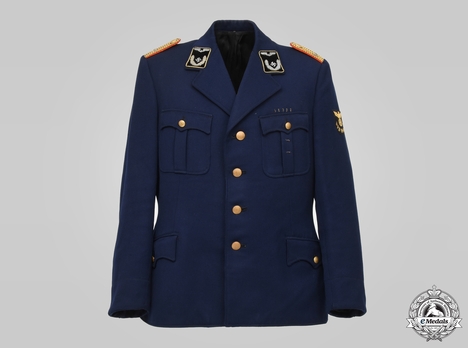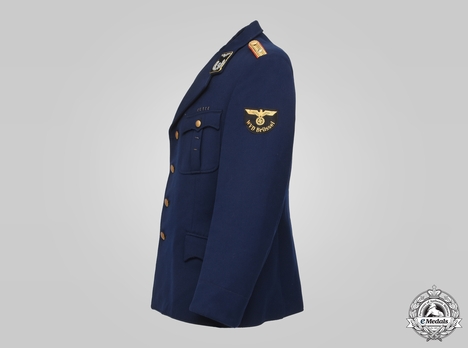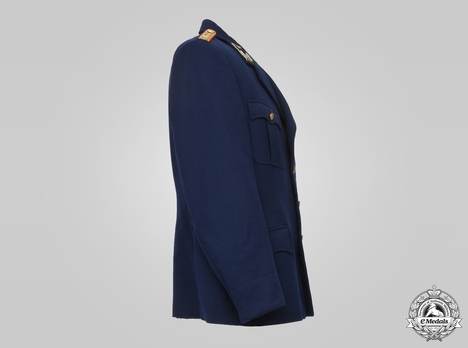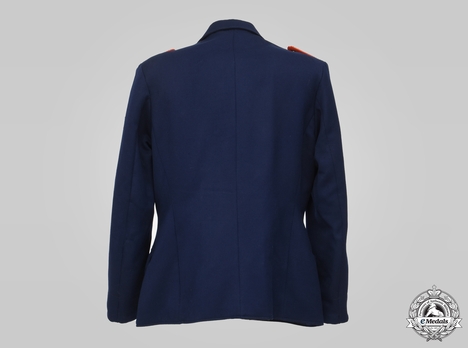Reichsbahn Tunic
CATEGORY: Version
SKU: 72.GOR.02.01.001.000
Estimated market value:




Estimated market value:
An extremely well-preserved Reichsbahn Officer’s service tunic, constructed of a smooth dark blue wool twill. It features a low-set collar transitioning into double breast flaps, with the former flanked on each side by tabs. Both constructed of black doeskin wool bases, the tabs are trimmed with gold bullion wire piping, and pinned with zink alloy insignia. Each tab measures 48 mm (w) x 66 mm (h). The shoulders are adorned with boards constructed of cardboard-reinforced wool bases, bearing four bands of gold bullion wire piping interspersed with dark blue threaded chevrons. Each board is pinned with a gilded bronze rank pip, is secured in place with machine stitching at the outer edge and with gilded magnetic metal buttons on the inner edge, and measure 25 mm (w) x 105 mm (l). Stitched onto the upper left arm is an insignia consisting of a black rayon base bearing a machine-embroidered German national eagle clutching a wreathed mobile swastika, set above an inscription of “WVD BRÜSSEL” for Wehrmachtsverkehrsdirektion (Wehrmacht Traffic Directorate) Brussels. It measures 80 mm (w) x 60 mm (h) overall. Each breast flap features two pockets, all opening with scalloped horizontal flaps with reinforced buttonholes meeting gilded magnetic metal buttons. Five horizontally-arranged threaded loops are set above the upper left pocket, with two vertically-arranged threaded loops overlaying the pocket itself, for the accommodation or a ribbon bar and decoration with vertical pinback, respectively. The tunic closes with four gilded magnetic metal buttons on the right flap meeting an equal number of reinforced buttonholes on the left flap. All buttons on the tunic are maker marked on the reverse with the logo of Overhoff & Cie, Lüdenscheid, indicating no replacements. The interior is fully encompassed by a black rayon liner, plain with the exception of dual breast pockets. Unmarked. While extremely well-preserved, minor issues consistent with age are evident, and includes some mothing to the right shoulder board, as well as loss of finish to some of the insignia. It is in an overall extremely fine condition.
The Deutsche Reichsbahn (German National Railway) was created after the First World War in 1920 by combining the formerly independent state railways of the abolished German Empire into a national organisation. Under NSDAP rule, the German state railway system was reorganised in the 1930s to better meet the needs of the economy and to prepare for war, eventually supplying the front lines with soldiers and supplies. The Reichsbahn also had an infamous role to play in the Holocaust, transporting Jews and other “undesirables” to concentration and extermination camps.
The Bahnschutzpolizei (railway protection police) was founded in 1939 as a merger of the Bahnpolizei (railway police) and the Reichsbahnschutz (railway protection force), the latter being regular railway employees that, beyond their normal functions, additionally served as railway security personnel.
The Bahnschutzpolizei as a railway sub-organisation was made up of policemen that were employed by the Reichsbahn rather than the German police force. Their task was to ensure railway safety as well as preventing railway-related espionage and sabotage. During the war, most members of the Bahnschutzpolizei served in the occupied Eastern European territories.
In the early 1930s, the Reichsbahn uniforms were the same as the ones worn during the time of the Weimar Republic. They followed regulations that were first implemented in May of 1924, with additional modifications over the years. The tunic was dark blue and either single-breasted with a hidden button closure or double-breasted with 5 buttons each. Both versions were worn closed at the neck. The tunic didn’t feature any cuffs. There were no breast pockets either, only two concealed hip pockets with flaps.
New uniform regulations were released in July of 1935. Subtle changes led to the uniforms bearing a closer resemblance to those of the military. The tunic remained dark blue and could be worn either with an open collar or a closed collar. Two breast pockets were introduced on top of the already existing two hip pockets, and all featured curved buttoned flaps.

Comments
Sign in to comment and reply.


Scroll Top